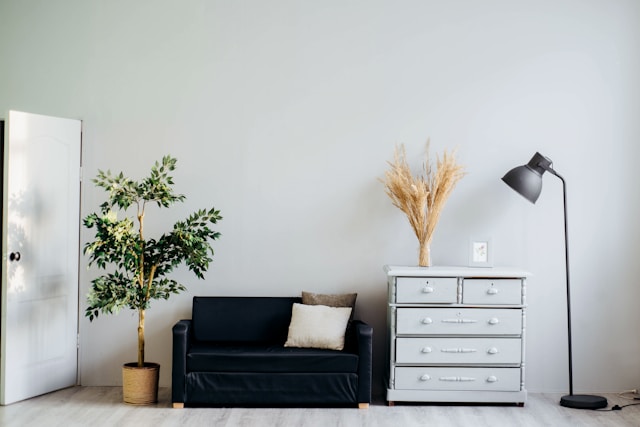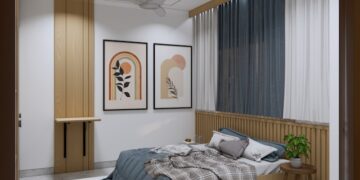Adding an accent wall is one of the easiest and most cost-effective ways to give any room a stylish makeover. Whether you prefer a bold, modern look or a subtle, classic design, there are countless ways to create a unique focal point in your space. In this guide, we’ll explore DIY accent wall ideas that can instantly elevate your home’s aesthetic, along with step-by-step instructions to help you achieve a professional finish.
Why Add an Accent Wall?
Accent walls serve as a focal point in a room, drawing the eye and adding personality without overwhelming the space. They can make a small room feel larger, add texture to a bland wall, or bring warmth and depth to a neutral space. The best part? You don’t need to be an expert to create a stunning accent wall on your own.
Types of DIY Accent Walls
Painted Accent Walls
A simple yet impactful way to transform a room is with a painted accent wall. Paint allows for endless creativity, whether you choose a solid bold color or intricate patterns.
- Geometric Patterns: Use painter’s tape to create triangles, diamonds, or abstract shapes for a contemporary feel.
- Color Blocking: Experiment with two or more contrasting shades to add depth and interest.
- Ombre Effect: Blend colors gradually from light to dark for a soft, sophisticated look.
- Stripes and Stencils: Vertical or horizontal stripes can make a room feel taller or wider, while stencils allow for detailed, decorative designs.
Wood Accent Walls
Wood adds warmth and texture, making it a perfect choice for rustic, farmhouse, or modern interiors.
- Shiplap: Horizontal wooden planks create a classic farmhouse-inspired look.
- Board and Batten: A chic and budget-friendly way to add dimension to walls with wooden panels.
- Reclaimed Wood: A sustainable option that adds character with its natural, weathered texture.
- Slatted Wood Panels: Vertical slats create a sleek, contemporary design that enhances modern spaces.
Wallpaper and Peel-and-Stick Murals
Wallpaper is a great way to add bold patterns or textures without the commitment of paint.
- Traditional Wallpaper: Timeless florals, damask, or abstract prints can make a dramatic statement.
- Peel-and-Stick Wallpaper: Ideal for renters, as it’s easy to remove without damaging walls.
- Textured Wallpapers: Grasscloth, faux brick, or metallic finishes add depth and richness.
- Large-Scale Murals: Landscape or abstract murals create a unique and artistic focal point.
Textured Accent Walls
Adding texture can enhance the visual appeal of your room and create a dynamic space.
- Brick or Faux Brick Panels: Achieve an industrial or rustic look without the expense of real brick.
- Faux Concrete Walls: Modern and edgy, these work well in contemporary or minimalist designs.
- Plaster or Stucco Finishes: A Mediterranean-inspired style that adds old-world charm.
- 3D Wall Panels: Sculptural panels made of MDF, PVC, or foam can create an eye-catching effect.
Gallery and Decorative Walls
A gallery wall allows for personalization with framed artwork, photographs, or mixed-media pieces.
- Floating Shelves: Display books, plants, or decorative objects for a curated look.
- Mirror Accent Wall: Mirrors reflect light, making small rooms appear larger and brighter.
- Wall Paneling: Wainscoting, beadboard, or molding can add elegance and architectural interest.
Fabric and Upholstered Walls
For a cozy and luxurious feel, consider using fabric or upholstered panels.
- Padded Panels: Great for bedrooms, these panels provide both aesthetics and soundproofing.
- Tapestry or Textile Wall Hangings: Bohemian or global-inspired designs can add softness and color.
- DIY Upholstered Wall: Attach fabric-covered foam panels for a plush, sophisticated backdrop.
How to Create a Simple DIY Accent Wall
Step 1: Choose the Right Wall and Design
Select a wall that naturally draws attention, such as the one behind a bed, sofa, or dining table. Consider the room’s existing decor, color palette, and lighting to ensure your accent wall complements the space.
Step 2: Gather Materials and Tools
Depending on your chosen design, you may need:
- Paint, brushes, rollers, painter’s tape (for painted walls)
- Wallpaper, adhesive, smoothing tool (for wallpapered walls)
- Wood panels, nails, saw, measuring tape (for wood walls)
- Fabric, foam panels, staple gun (for upholstered walls)
Step 3: Prepare the Wall
- Clean the wall thoroughly to remove dust and grease.
- Patch any holes or imperfections with spackle.
- Sand the surface if necessary to ensure smooth application.
Step 4: Execute Your Design
- Painting: Use painter’s tape to mark off sections, and apply multiple coats for even coverage.
- Wallpapering: Start from one corner and smooth out air bubbles as you apply each strip.
- Wood Paneling: Secure panels with nails or adhesive, ensuring proper alignment.
- Fabric Installation: Stretch fabric tightly over foam panels and secure with a staple gun.
Step 5: Finishing Touches
- Seal paint with a protective topcoat if needed.
- Add trim or molding for a polished look.
- Arrange furniture and decor to enhance the new accent wall.
Common Mistakes to Avoid
- Choosing overly trendy designs: While it’s great to experiment, some trends may feel outdated quickly.
- Skipping proper wall prep: Failing to clean, sand, or prime can lead to uneven results.
- Ignoring scale and proportion: Ensure your design fits well within the room’s dimensions.
- Using low-quality materials: Invest in good paint, wallpaper, or wood for a long-lasting finish.
Final Thoughts
A DIY accent wall is an excellent way to bring personality and style into your home without a full renovation. Whether you opt for a bold painted design, a rustic wood feature, or a modern textured look, the possibilities are endless. Take the time to plan your design, gather the right materials, and enjoy the creative process.









